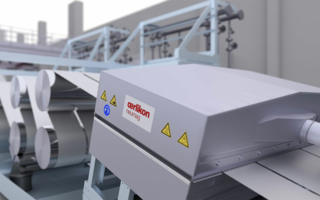22/02/2024 – Recycled fibers
Machinery and services for circularity
Many end-users expect recycled materials to be in textile products they purchase. However, there are still many technical and economic issues facing yarn and fabric producers using recycled resources. Members of the Swiss Textile Machinery Association offer some effective solutions to these challenges.
Synthetic recycled materials such as PET can usually be treated similarly to new yarn, but there are additional complexities where natural fibers like wool and cotton are involved. The trend is said to go towards mechanically recycled wool and cotton fibers. How are cirularity concepts addressed by Swiss companies?
Spinning recycled cotton
The use of mechanically recycled fibers in spinning brings specific quality considerations: they have higher levels of short fibers and neps – and may often be colored, particularly if post-consumer material is used. It´s also true that recycled yarns have limitations in terms of fineness. In general, short fibers such as those in recycled material can easily be handled by rotor spinning machines. Processing recycled cotton poses specific challenges, such as higher levels of short fibers and neps, as well as potential color variations. For ring spinning, the shorter the fibers, the more difficult it is to guide them through the drafting zone to integrate them into the yarn body. Still, for wider yarn counts and higher yarn quality, the focus is now shifting to ring spinning. The presence of short fibers is a challenge, but companies like Rieter offers solutions to address this issue.
Knitting recycled wool
Mechanical procedures involved in recycling wool fibers, including shredding and re-spinning, can affect yarn quality and durability. Steiger´s continuous testing of new yarns ensures knitting machines are equipped to handle recycled wool effectively. Moreover, adjustments to machinery, such as incorporating positive yarn suppliers, are essential to control fiber tension during the knitting process, ensuring satisfactory quality despite the challenges posed by natural fibers.
From fibers to nonwovens
Nonwovens technology was born partly from the idea of recycling to reduce manufacturing costs and to process textile waste and previously unusable materials into fabric structures. Nonwovens production lines, where fiber webs are bonded mechanically, thermally or chemically, can easily process almost all mechanically and chemically recycled fibers. Autefa Solutions enables a true closed-loop system. By offering nonwovens lines capable of processing almost all mechanically and chemically recycled fibers, Autefa Solutions facilitates the production of various products, including liners, wipes, wadding, and insulation, with minimal environmental impact.
In conclusion, services, technology, and machines from members of Swiss Textile Machinery support the efforts of the circular economy to process recycled fibers. The machines incorporate the know-how of several decades, with the innovative power and quality standards in production and materials. .Stäubli´s global ESG (environmental, social & governance) strategy for example defines KPIs in the context of energy consumption, machine longevity and the recycling capacity in production units worldwide, as well in terms of machinery recyclability. As a result, the machine recyclability of automatic drawing in machines, weaving systems and jacquard machines ranges from 96% to 99%. By embracing circularity concepts and continually innovating, companies are not only meeting the demands of today´s environmentally conscious consumers but also shaping the future of sustainable textile production.




